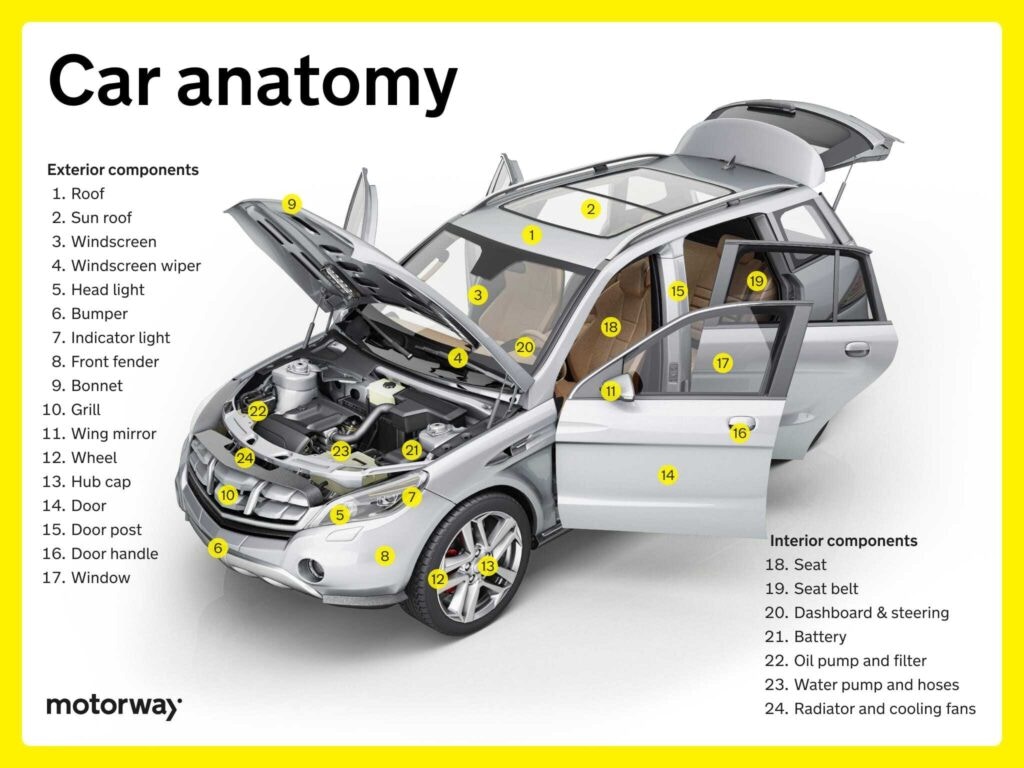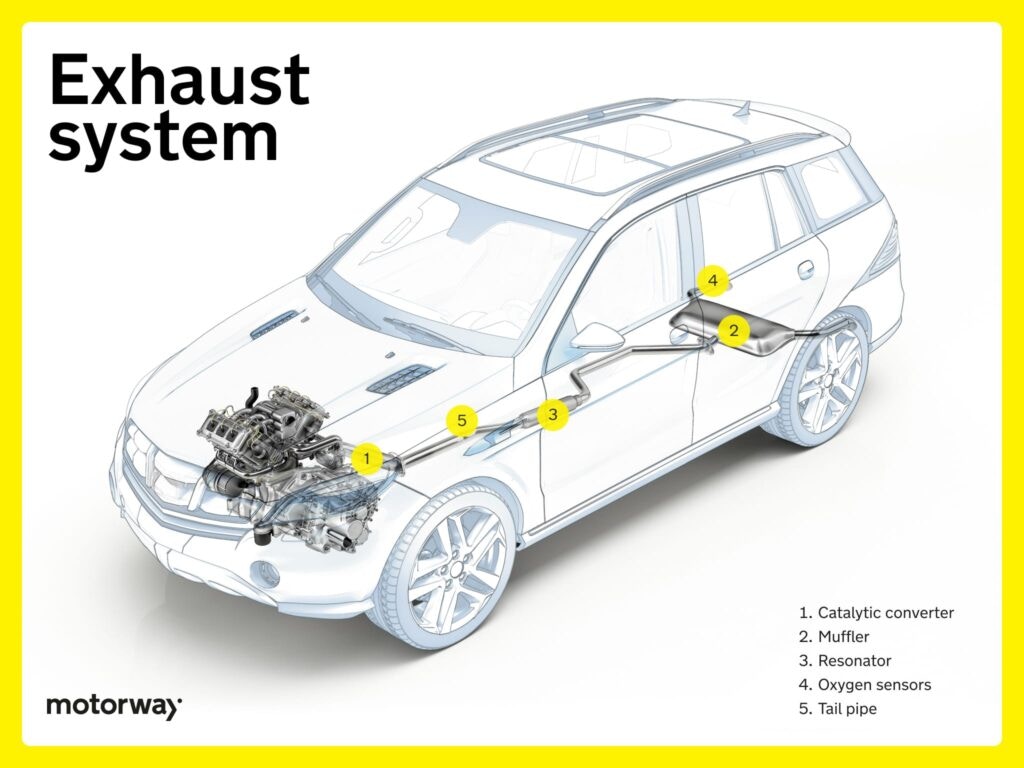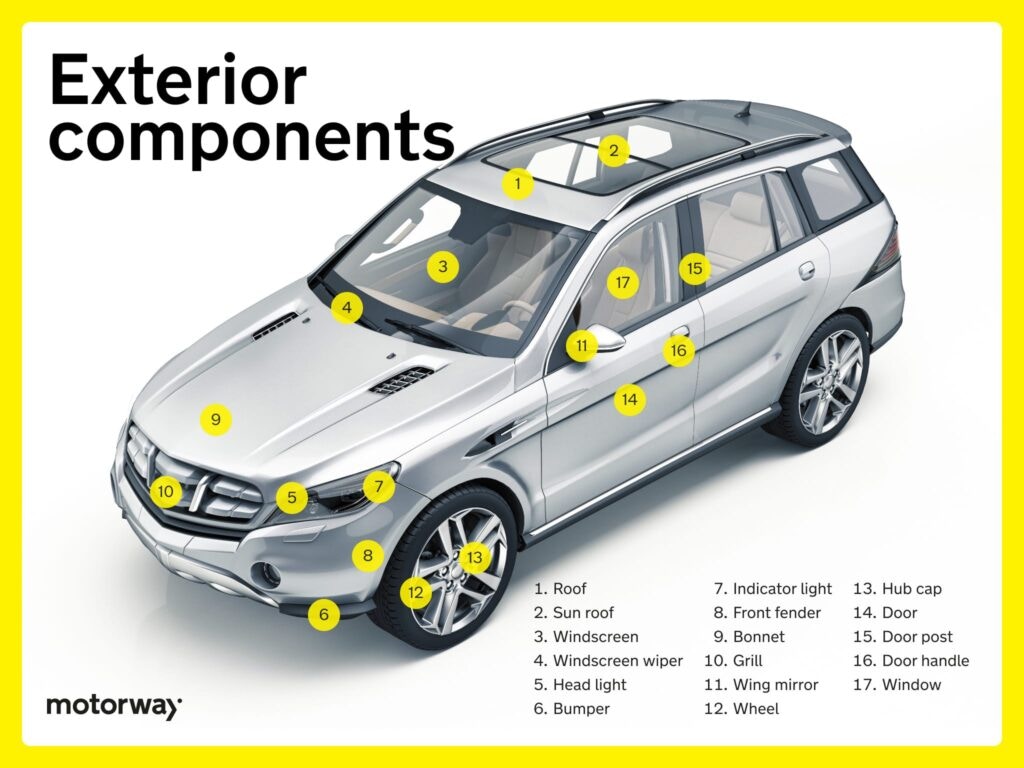Car anatomy: what are the parts of a car?
Part of being a responsible car owner is to be proactive about maintenance. However, it can be intimidating to try to wrap your head around all the key mechanical parts of cars, in order to make informed decisions when repairs are in order.
One thing is for sure: you definitely want to know which car parts are dangerous if they’re malfunctioning, and which are fairly inexpensive to keep in good nick.

Explore the inner workings of a car below, from pistons to spark plugs, and understand the key components that form the anatomy of any vehicle.
- Engine components
- Powertrain and gearboxes
- Fuel and ignition systems
- Cooling and lubrication
- Electrical system
- Suspension and steering
- Braking system
- Exhaust system
- Wheels and tyres
- Interior and exterior components
- FAQs
Engine components

Keeping your engine in good condition will preserve your car’s value and keep your running costs low.
Cylinder block and pistons
The engine’s cylinder block is a solid structure within the engine, serving as the powerhouse’s foundation. It contains individual cylinders, which are hollow tubes where controlled combustions occur.
Pistons, held securely by piston rings within these cylinders, undergo up-and-down movements. They play a crucial role in converting explosive energy from combustion into a driving force, propelling the vehicle forward. The piston-cylinder interaction is pivotal, making it the primary component responsible for generating automotive power.
Crankshaft and camshaft
Also at the heart of an engine’s inner workings are the crankshaft and camshaft. The crankshaft transforms the vertical motion of pistons into rotational energy, providing the driving force for the vehicle.
Simultaneously, the camshaft manages the precise timing of valve openings, ensuring seamless combustion. Together, they synchronise internal combustion events with accurate movements, contributing to a smooth and propulsive motion of the car.

Intake and exhaust manifolds
These vital components can be visualised as the lungs of a car, managing the flow of air. The intake manifold draws in oxygen for combustion, while the exhaust manifold expels spent gases, sending them out through the exhaust.
Together, they optimise the car’s internal combustion engine performance, ensuring a harmonious balance of power and efficiency. Note that intake and exhaust manifolds are not present in electric vehicles.
Powertrain and gearboxes

Different types of gearboxes, otherwise known as transmission
Manual gearboxes
Manual gearboxes give the driver control of the car’s gears.
Requiring the manual engagement and disengagement of gears through the use of a clutch, these gearboxes let drivers respond constantly to the driving conditions around them, such as road slipperiness, acceleration, and deceleration.
Automatic gearboxes
Automatic gearboxes make driving easier by shifting gears smoothly without needing the driver to do anything. This means the gears change without a driver operating a clutch or gear stick.
Inside these gearboxes is a torque converter, a fluid coupling that handles gear changes smoothly.
CVTs
Continuously Variable Transmissions (CVT) are the most sophisticated iteration of gearbox mechanics. Using a system of pulleys and belts, CVTs provide an infinite range of gear settings, resulting in a seamless and continuous acceleration experience.
This design not only optimises fuel efficiency, but also adapts dynamically to changing driving conditions, making CVTs a high-performance choice.
Differential and driveshaft
In a car’s power system, the differential and driveshaft work together but handle different jobs. The driveshaft carries this power from the transmission to the wheels.
Meanwhile, the differential ensures power gets evenly distributed to the wheels, allowing for smooth turns. Together, they create a harmonious system for your car’s motion.
Clutch and torque converter
In the world of gears and transmission, the clutch and torque converter play important roles. In manual transmissions, the clutch helps the driver engage and disengage gears for precise control.
In automatic transmissions, the torque converter smoothly transfers power, ensuring gears shift seamlessly, making your drive both smooth and dynamic.
Fuel and ignition systems

Fuel injection system
A key component of modern engines, the fuel injection system ensures optimal combustion. The fuel injectors precisely deliver fuel into the engine cylinders, enhancing efficiency and power.
This technology replaces a part that was renowned for breaking down due to clogging and other wear and tear: carburettors. Fuel injectors offer better fuel distribution, improved performance, and reduced emissions.
Spark plugs and ignition coils
The ignition system is made up of spark plugs and the ignition coil. They work together to ignite the engine’s fuel-air mixture. The spark plug produces the spark needed for combustion, while ignition coils amplify the voltage.
The two parts must remain in synchrony to ensure efficient and fast ignition, which is crucial for optimal engine performance, responsiveness, and fuel efficiency.
Throttle body and air intake system
The throttle body and air intake system collaborate to control the airflow into the engine. The throttle manages the quantity of air entering the engine, and the air intake system ensures a clean and efficient air supply.
Working together, they oversee the engine’s ‘breathing’ – a crucial aspect for achieving peak power, fuel efficiency, and overall performance.

Cooling and lubrication
Radiator and cooling fans
The radiator and cooling fans are the two biggest defences against internal combustion engines overheating.
The radiator dissipates heat from the coolant, while the cooling system enhances airflow, expelling excess heat. The two parts ensure the engine maintains an optimal temperature, safeguarding against damage and promoting efficient performance.
Water pump and hoses
Two further cooling systems crucial to regulating the engine’s temperature are the water pump and hoses. The water pump circulates coolant, absorbing heat, while hoses allow the coolant to move around.
EV battery cooler system
Electric vehicles use a different cooling system, focused on cooling the battery and the electric motor. The battery cooler, akin to a traditional radiator, dissipates heat from the battery coolant, while the cooling system enhances airflow, expelling excess heat.
In EVs, maintaining an optimal temperature is vital for the longevity and efficiency of the battery and electric motor.
Oil pump and oil filter
The oil pump circulates engine oil, ensuring components stay well-lubricated for smooth operation. Simultaneously, the oil filter sieves out impurities, preserving engine health. Between them they extend the engine’s longevity.
Electrical system

Battery
The car battery is the vehicle’s initial energy source, kickstarting the engine and supporting electrical functions. All cars have batteries, not just EVs. If your battery has a fault or loses capacity, you’ll have to replace it.
Alternator
The alternator converts mechanical energy from the engine’s rotation to electrical energy, allowing it to recharge the battery and fuel the car’s electrical system. It supplies power to the electrical components of the car while the engine’s running.
Most importantly, the alternator regulates the voltage to maintain a consistent electrical supply. It prevents overcharging of the battery and ensures that the electrical components receive the right amount of power.
Starter motor and solenoid
The starter motor and solenoid work together to start the engine. The solenoid activates the starter motor, which turns the engine to kickstart the combustion process.
This coordinated effort transforms electrical energy into mechanical motion.
Wiring harness and fuses
The wiring harness channels electricity throughout the vehicle, connecting various components. Fuses, strategically placed, protect against electrical overloads.
Together, they ensure a safe and organised flow of electrical power, preventing potential malfunctions and safeguarding the entire electrical network.
Suspension and steering

Shock absorbers and struts
Shock absorbers and struts are essential components in a car’s suspension system. Shock absorbers, typically four in a car, are designed to absorb shocks and vibrations, providing a smoother ride by managing vertical movements near the wheels.
Struts, often located at the front and sometimes rear, offer both structural support and shock absorption, contributing to the stability of the vehicle. Together, they enhance driving comfort by dampening the impact of bumps and uneven road surfaces, ensuring a more stable and enjoyable ride.
Control arms and bushings
In the chassis the control arms and bushings provide stability and smooth handling. Control arms connect the suspension to the frame, while bushings provide flexibility.
This duo absorbs road imperfections, maintains tyre alignment, and ensures a balanced ride.
Power steering pump and rack
These parts are key for responsive steering. The pump generates hydraulic pressure, while the rack converts it into controlled motion, making steering effortless.
Together, they provide precise and smooth manoeuvrability, for ease of navigation on the road.
Braking system

Brake pads
These frictional components, usually made of composite materials, press against the brake rotors, converting kinetic energy into heat and facilitating controlled deceleration.
Their robust design ensures reliable braking performance when the brake pedal is applied, contributing to both safety and the longevity of the braking system. These are at risk of wearing out over time, especially if you do not drive evenly.
Brake callipers
Brake callipers are situated around the brake rotor and house pistons that, upon receiving hydraulic pressure, clamp the brake pads onto the rotor, generating the necessary friction for controlled deceleration. Their precision ensures responsive and reliable braking, contributing to overall driving safety.
Exhaust system

Catalytic converter
The catalytic converter in an internal combustion engine transforms harmful gases like carbon monoxide into less harmful substances through catalysis.
This ingenious device reduces vehicle emissions, contributing to cleaner air and environmental health, making it a key component in compliant, automotive systems.
Muffler and resonator
The muffler and resonator collaborate in a car’s exhaust system to keep noise levels correct. The muffler’s main job is to reduce noise, while the resonator fine-tunes sound frequencies, adjusting the exhaust notes.
When a driver can hear how the car is running, they’re able to drive more adaptively and enjoy a pleasant driving noise.
Oxygen sensors
The sensors monitor oxygen levels in the exhaust gases, providing crucial data for the engine control unit. This information enables precise fuel injection, optimising combustion efficiency and reducing emissions.
Interior components

Seats & their belts
Seats are designed for comfort and support, available in various materials and configurations. Seat belts, essential for safety, secure occupants during travel, often equipped with features like pretensioners and force limiters.
Dashboard & steering functions
The dashboard serves as a visual command centre, relaying essential information like speed, fuel levels, and engine status. It provides a comprehensive snapshot, ensuring driver awareness.
Paired with the steering wheel encompassing power-assisted features and controls for indicators, wipers, and multimedia systems.
Exterior components

Features & controls on doors
The features and controls on doors are integral components enhancing convenience and safety for drivers. All cars can be expected to contain electric window controls, door locks, and mirror adjustments.
Some models also incorporate advanced features such as keyless entry and power-operated doors, contributing to a more streamlined and user-friendly driving experience.
Wheels and tyres
Types of tyres and their functions
| Type of tyre | Function |
| Summer tyres | Crafted for warm weather, and excelling in both dry and wet conditions with optimal grip and precise handling. |
| Winter tyres | Engineered for cold climates, featuring specialised treads for improved traction on snow and ice-covered roads. |
| All-season tyres | Versatile performers suitable for various conditions, balancing traction and durability in both wet and dry weather. |
| Performance tyres | Designed for sportier driving, prioritising handling, grip, and responsiveness at higher speeds. |
| Off-Road tyres | Built for challenging terrains, featuring rugged treads and reinforced sidewalls for enhanced traction and durability. |
| Run-flat tyres | Equipped with reinforced sidewalls, enabling drivers to continue at reduced speeds for a limited distance even after a puncture. |
| Touring tyres | Focused on a smooth and comfortable ride, ideal for long-distance journeys with low road noise and good handling. |
Wheel construction guide: alloy vs. steel wheels
When it comes to wheel construction, there are several designs to consider:
- One-piece construction: The entire wheel is crafted from a single piece of material, typically alloy or steel. This design is commonly used for both alloy and steel wheels.
- Two-piece construction: In this design, the wheel consists of two main parts – the centre and the outer rim. These parts are usually bolted or welded together. Two-piece constructions are often found in performance or custom wheels.
- Three-piece construction: The wheel is composed of three separate pieces – the centre, the outer rim, and an inner hoop. This modular design allows for greater customization, making three-piece wheels a popular choice in the aftermarket scene.
- Forged construction: Forged wheels are made from a solid piece of metal that is compressed under high pressure. This process creates a wheel that is stronger and lighter compared to cast wheels. Forged wheels are often used in high-performance and racing applications.
- Multi-piece construction: This design combines multiple components, often including a centre section, an outer rim, and bolts. Multi-piece wheels offer versatility in terms of sizing and customization.
The choice of construction impacts factors such as weight, durability, and aesthetics, allowing drivers to select wheels that align with their performance and style preferences. You can also sometimes have a choice of material:
- Alloy wheels: Made from a mix of metals, often aluminium or magnesium. They are lightweight, providing better heat dissipation and enhancing a vehicle’s appearance.
- Steel wheels: Constructed from steel, ensuring robustness. Although heavier than alloy wheels, they are durable, cost-effective, and well-suited for rugged driving conditions.
Tyre pressure monitoring system (TPMS)
The TPMS is a safety feature, continuously monitoring tyre air pressure through sensors in each tyre. Transmitting real-time data to the vehicle’s computer, it issues warnings if pressure deviates from optimal levels. This promotes safety, fuel efficiency, and extends tyre lifespan by ensuring proper inflation.

FAQs
What parts are under a car?
Under a car, you’ll find crucial components like the engine, transmission, suspension system, vehicle’s exhaust system, and fuel system, all working in tandem to ensure the vehicle’s proper functionality and performance.
How many car parts are on a car?
The number of car parts can vary, but modern vehicles can have over 30,000 individual parts, encompassing various systems and components, highlighting the intricate engineering and complexity involved in car design. EVs typically have fewer parts, as their engines are much simpler, relying on batteries rather than mechanical parts.
What are the important parts of a vehicle?
Important vehicle parts include the engine, transmission, brake system, steering system, suspension, and electrical components, each playing a vital role in ensuring the vehicle’s safety.
What parts of a car can be sold separately?
Components such as engines, transmissions, body parts, and specific electrical parts can be sold separately, depending on the demand and availability, offering flexibility for repairs, replacements, or upgrades.
Why is there a shortage of car parts?
A shortage of car parts can arise due to disruptions in the supply chain, increased demand for specific components, manufacturing challenges, and global events affecting production and distribution.
Need to sell your car?
Want to learn more about owning, maintaining, and selling your car? Check out more of our guides here, covering everything from Clean Air Zones to car tax, and plate changes to part exchange.